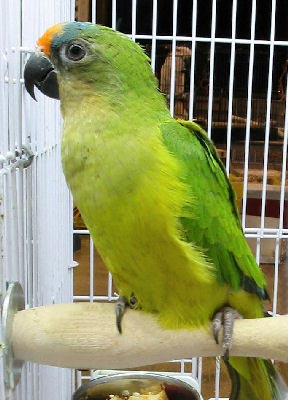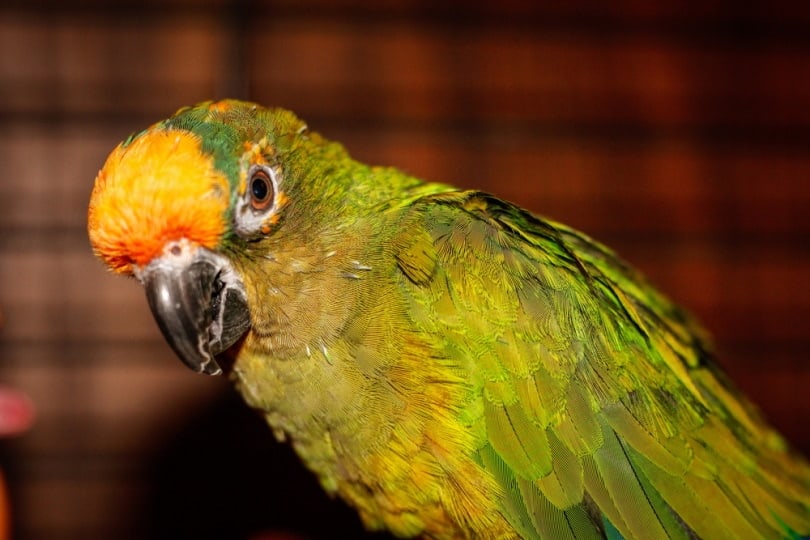
The Peach-fronted Conure is one active, fun-packed little bird… and can be a great companion!
“Peaches” shown in the picture above is about three and a half years old. She is very friendly once she gets to know you, but is a little shy at first. This was true until her new owner, an adult woman, opened her cage to say “hi”. Peaches hopped right out on her finger. Needless to say, it was a match of “love-at-first-sight”!
For more information about the care of Conures see:
Guide to a Happy, Healthy Conure
- Kingdom: Animalia
- Phylum: Chordata
- Class: Aves
- Order: Psittaciformes
- Family: Psittacidae
- Genus: Aratinga
- Species: aurea aurea
Scientific Name:
Subspecies:
- Peach-fronted Conure
Aratinga aurea aurea - Golden-crowned Conure
Aratinga aurea - Greater Peach-fronted Conure
Aratinga aurea major
Distribution:
These birds have the greatest natural range of all but the White-eyed conures. They are native to Brazil, south of the amazon and eastward to Rio Madeira, eastern Bolivia, Mato Grosso, and Sao Paulo.
Description:
The Peach-fronted conure has a grayish-green back with a lighter green (olive) color on the breast. The forehead and part of the crown are bright orange. The rest of the crown is blue-green. There are black tips on the wings and blue tips on the tail. The beak is black.
They are similar in appearance and size to the three subspecies of Orange-fronted Conures (see the Half-Moon Conure) but have a smaller black beak rather than horn colored, and their colored frontal band is larger.
Size – Weight:
These birds get up to 10″ (25 cm) and 3.7 ozs. (105 g).
Care and feeding:
A roomy cage is required unless the bird is to be let out for extended periods. Many birds can spend most of their time on a play pen or parrot perch. They eat a variety of seeds, nuts, fruits, and commercial pellets, as well as the same nutritional foods humans eat.
See About Conures: Housing and About Conures: Care and Feeding for more information.
Social Behaviors:
They live in pairs or small groups of 10 to 20 birds. They love to play, and can be fairly destructive if not watched. They can also be rather noisy. Despite all this, they make a real fun pet and are very popular.
Activities:
Loves to climb and play. Provide lots of toys.
 Peaches Photo Courtesy: Peaches Photo Courtesy: David Brough |
Breeding/Reproduction:
They breed readily if they have the right size aviary. The hen lays two to four eggs which are incubated for about 26 days. The young fledge (leave the nest) after about 52 days. The nest box size should be 13″ x 10″ x 10″. with an entrance hole about 3.25″ in diameter.
Potential Problems:
As with many Aratinga species, Peach-fronted Conures can be noisy,though not nearly as noisy as most Aratinga species.
See About Conures: Potential Problems for more information.
Availability:
This bird is generally available. Your best bet is to find one at a pet store or a reputable breeder.
Featured Image Credit: Boost Life Photography, Shutterstock
